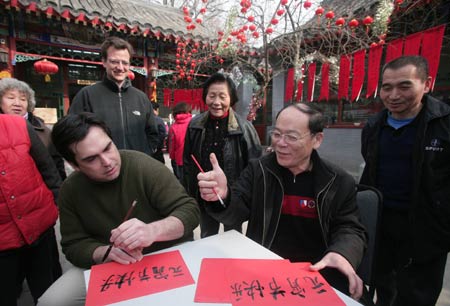|

|
|
A U.S. citizen (L) learns the brush calligraphy of Chinese characters, literally, "Happy Lantern Festival", during a get-together party of local residents and foreigners living on Dongsisitiao Hutong (Alley), inside a quadrangle courtyard, the typical residential rectangular compound, to live a jovial Chinese lunar Lantern Festival, in Beijing, Feb. 8, 2009. [Xinhua/Hao Fei]
|
Traditionally an occasion for family reunion, the Lantern Festival on Monday was celebrated widely by Chinese people in different ways.
In a Siheyuan, or walled quadrangle residence, in the Dongcheng district of Beijing, some foreigners were learning to make yuanxiao, a kind of snack like glue pudding which was made especially for the festival.
"Put the stuffing inside...that's right," a granny surnamed Li said while demonstrating the procedure herself.
A Mr. Jin made a red paper lantern and wrote "happy Lantern Festival" with his brush pen. Following his instruction, an American who would like to be identified with his Chinese name Zhang Zhimai wrote "yuanxiao is delicious".
"The Lantern Festival is important to the Chinese people. We invited the foreign friends to join us so as to help them feel the traditional Chinese culture," said Wang Xi, head of the Dongsisitiao community.
In the neighboring Tianjin Municipality, the third session of "lantern making contest" is going on, which is set from Sunday to Tuesday.
The lanterns made by citizens are hung on the ancient crabapple trees in the Old City Museum.
"Some folk artists are invited to make performances of calligraphy, painting, paper cutting, embroidery, flour sculpture, etc.," said Wang Liwen, curator of the museum.
In Inner Mongolia, the tradition of Zhuandeng was followed. Zhuandeng literally means walking around the lanterns, which bore a history of more than 3,000 years. A shelf made by more than 300 poles was made to hold 365 lanterns, each representing a day in one year.
"People believe that walking around the shelf symbolizes walking around hardship in the year," said Wang Yunliang, who organized the activity in Hohhot. Similar rituals were performed in Baotou and Bayannur as well.